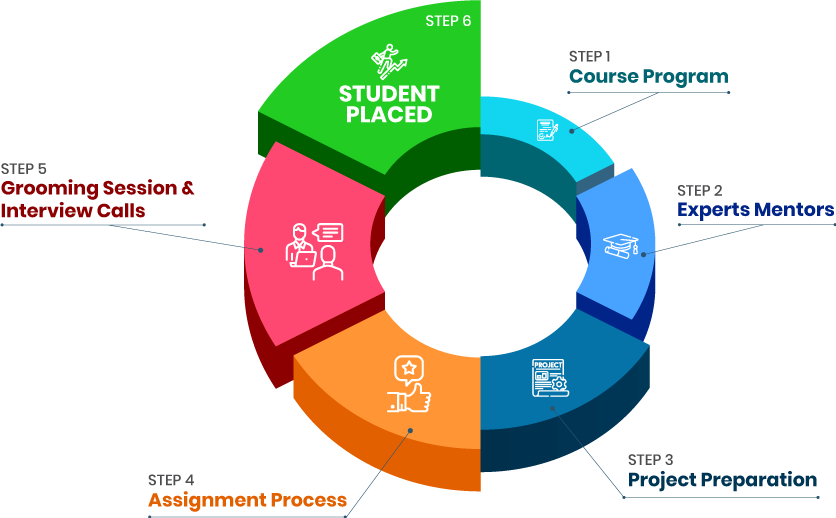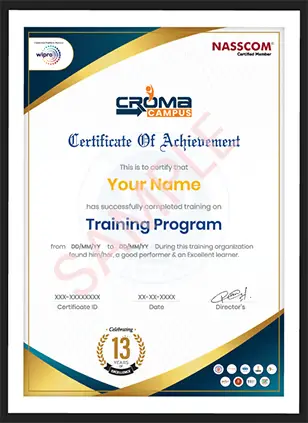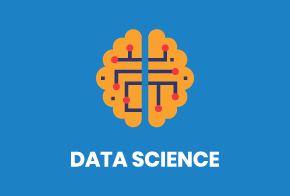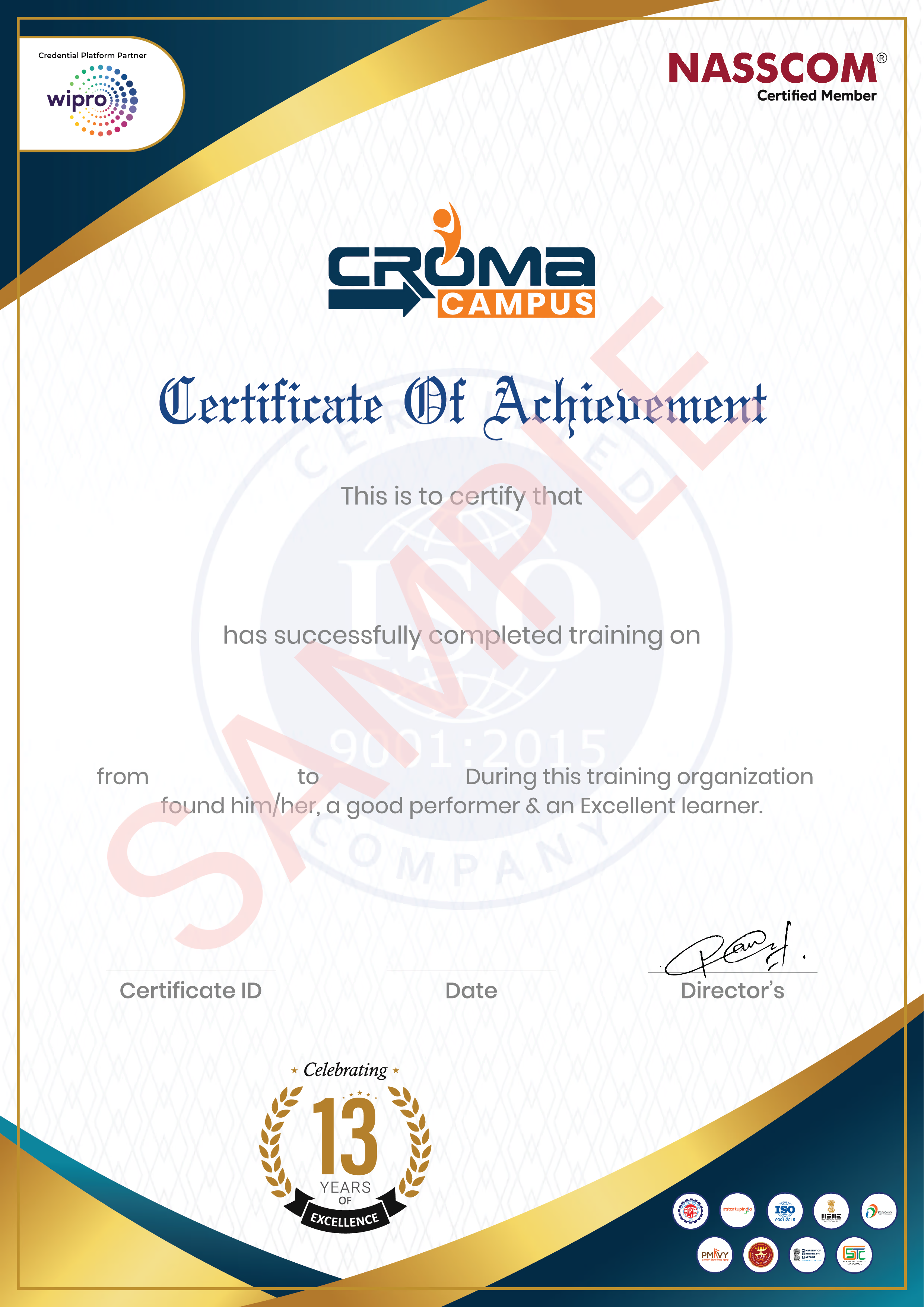- Data Science training in Lucknow offers a great opportunity for those looking to start or advance their career in data science. A Data Science course in Lucknow covers essential topics like data analysis, machine learning, statistics, and data visualization.
- Benefits of enrolling in a Data Science institute in Lucknow:
- Data Science in Lucknow is becoming increasingly popular due to the city's growing tech industry and the high demand for skilled data scientists. With excellent training and support, Lucknow is a great place to build your data science career. Whether you're just starting out or looking to enhance your skills, data science training in Lucknow can help you achieve your goals.
Expert Instructors: Learn from experienced professionals.
Hands-on Training: Work on real-world projects.
Comprehensive Curriculum: Gain knowledge in all key areas of data science.
Networking Opportunities: Connect with industry professionals and peers.
Career Support: Receive guidance and assistance in job placements.
- The goals of Data Science training in Lucknow are:
- These objectives ensure that students enrolled in a Data Science course in Lucknow at a leading Data Science institute in Lucknow are well-equipped for a successful career in data science.
Foundation Knowledge: Grasp key concepts in statistics, machine learning, and data analysis.
Hands-On Learning: Engage in practical projects and real-world applications.
Tool Mastery: Gain proficiency in Python, R, SQL, and Tableau.
Visualization Skills: Develop the ability to create impactful data visualizations.
Analytical Thinking: Enhance skills in problem-solving and data interpretation.
Job Preparedness: Get ready for industry demands and various career opportunities.
Ongoing Education: Keep up with the latest developments in data science.
Collaboration: Improve teamwork and communication abilities.
Ethical Awareness: Learn best practices for ethical data management.
Career Progression: Equip yourself for advanced roles like Data Scientist and Data Analyst.
- After completing a Data Science course in Lucknow with placement, you can look forward to competitive salary packages:
- Choosing the best Data Science course in Lucknow enhances your career prospects and earning potential. These courses provide comprehensive training, hands-on projects, and industry exposure, making you job-ready.
- Pursuing Data Science in Lucknow is a smart choice due to the citys growing tech industry and demand for skilled professionals. Graduates from a top Data Science institute in Lucknow are well-equipped with the latest tools and techniques, ensuring they stand out in the job market. Overall, completing a data science course in Lucknow can lead to a rewarding career with excellent salary prospects.
Entry-Level: Fresh graduates can expect salaries ranging from 4 to 7 lakhs per annum.
Mid-Level: Professionals with 2-5 years of experience can earn between 7 to 12 lakhs per annum.
Senior-Level: Those with over 5 years of experience can see salaries from 12 to 20 lakhs per annum.
- Learning Data Science in Lucknow offers numerous career benefits:
- Completing a Data Science course in Lucknow from a top institute boosts your skills and employability, paving the way for a successful career.
Enhanced Skills: Master tools like Python, R, SQL, and Tableau.
Practical Experience: Work on real-world projects.
Industry Readiness: Prepare for roles in IT, finance, healthcare, and e-commerce.
Higher Salaries: Enjoy competitive pay with potential for growth.
Networking: Connect with industry professionals and peers.
Career Advancement: Move up to roles like Data Scientist, Data Analyst, and Machine Learning Engineer.
Job Security: High demand for data science skills ensures job stability.
- A Data Science Online Course is popular due to following reasons:
- These factors make data science courses highly attractive to professionals.
High Demand: Growing need for data scientists across industries.
Lucrative Salaries: Competitive pay and substantial growth potential.
Versatile Skills: Applicable in IT, finance, healthcare, and e-commerce.
Advanced Problem-Solving: Gain analytical and problem-solving skills.
Cutting-Edge Technology: Involvement with machine learning and AI.
Career Advancement: Opens up advanced roles and opportunities.
Global Job Prospects: High demand worldwide.
Continuous Learning: Constantly evolving field with new trends.
- After completing a Data Science course in Lucknow, you can expect to take on various roles and responsibilities, including:
- These responsibilities prepare you to excel in various data science roles across different industries.
Data Collection: Gather and organize data from various sources.
Data Cleaning: Ensure data accuracy and quality by cleaning and preprocessing data.
Data Analysis: Analyse large datasets to extract meaningful insights and trends.
Model Building: Develop, test, and deploy machine learning models to solve business problems.
Data Visualization: Create visualizations and dashboards to present data findings clearly and effectively.
Statistical Analysis: Apply statistical techniques to interpret data and draw conclusions.
Collaboration: Work with cross-functional teams, including IT, marketing, and management, to integrate data-driven solutions.
Reporting: Prepare detailed reports and presentations to communicate insights and recommendations to stakeholders.
Tool Utilization: Use data science tools and programming languages such as Python, R, SQL, and Tableau.
Problem-Solving: Identify and address business challenges using data-driven approaches.
Continuous Learning: Stay updated with the latest trends and advancements in data science and machine learning.
- Lucknow's growing tech and business environment offers diverse opportunities for data science professionals. Here are some top industries hire data scientists in Lucknow.
IT and Software: Work on innovative solutions and software improvements.
Finance and Banking: Focus on risk management, fraud detection, and investment strategies.
Healthcare: Enhance patient care, manage medical records, and develop new treatments.
E-commerce: Optimize supply chains, improve customer experience, and tailor marketing efforts.
Manufacturing: Engage in predictive maintenance, quality control, and production efficiency.
Telecommunications: Improve network performance, analyze customer data, and enhance services.
Retail: Manage inventory, forecast sales, and understand consumer behavior.
Pharmaceuticals: Analyze clinical trials and support drug development processes.
Energy and Utilities: Boost efficiency, manage resources, and implement smart grid technologies.
Logistics and Supply Chain: Optimize routing, forecast demand, and manage inventory efficiently.
- Once you are done with Data Science Certification Course, you will get a training certificate valid worldwide and increase your chances of getting hired by leading industries globally at attractive salary packages.
- You May Also Read:
Why should You learn Data Science?
By registering here, I agree to Croma Campus Terms & Conditions and Privacy Policy
 Course Duration
Course Duration
160 Hrs.
Flexible Batches For You
19-Apr-2025*
- Weekend
- SAT - SUN
- Mor | Aft | Eve - Slot
21-Apr-2025*
- Weekday
- MON - FRI
- Mor | Aft | Eve - Slot
16-Apr-2025*
- Weekday
- MON - FRI
- Mor | Aft | Eve - Slot
19-Apr-2025*
- Weekend
- SAT - SUN
- Mor | Aft | Eve - Slot
21-Apr-2025*
- Weekday
- MON - FRI
- Mor | Aft | Eve - Slot
16-Apr-2025*
- Weekday
- MON - FRI
- Mor | Aft | Eve - Slot
Course Price :
Timings Doesn't Suit You ?
We can set up a batch at your convenient time.
Program Core Credentials
Trainer Profiles
Industry Experts
Trained Students
10000+
Success Ratio
100%
Corporate Training
For India & Abroad
Job Assistance
100%
Batch Request
FOR QUERIES, FEEDBACK OR ASSISTANCE
Contact Croma Campus Learner Support
Best of support with us
CURRICULUM & PROJECTS
Data Science Certification Training
- Creation of Excel Sheet Data
- Range Name, Format Painter
- Conditional Formatting, Wrap Text, Merge & Centre
- Sort, Filter, Advance Filter
- Different type of Chart Creations
- Auditing, (Trace Precedents, Trace Dependents)Print Area
- Data Validations, Consolidate, Subtotal
- What if Analysis (Data Table, Goal Seek, Scenario)
- Solver, Freeze Panes
- Various Simple Functions in Excel(Sum, Average, Max, Min)
- Real Life Assignment work
- Advance Data Sorting
- Multi-level sorting
- Restoring data to original order after performing sorting
- Sort by icons
- Sort by colours
- Lookup Functions
- Lookup
- VLookup
- HLookup
- Subtotal, Multi-Level Subtotal
- Grouping Features
- Column Wise
- Row Wise
- Consolidation With Several Worksheets
- Filter
- Auto Filter
- Advance Filter
- Printing of Raw & Column Heading on Each Page
- Workbook Protection and Worksheet Protection
- Specified Range Protection in Worksheet
- Excel Data Analysis
- Goal Seek
- Scenario Manager
- Data Table
- Advance use of Data Tables in Excel
- Reporting and Information Representation
- Pivot Table
- Pivot Chat
- Slicer with Pivot Table & Chart
- Generating MIS Report In Excel
- Advance Functions of Excel
- Math & Trig Functions
- Text Functions
- Lookup & Reference Function
- Logical Functions & Date and Time Functions
- Database Functions
- Statistical Functions
- Financial Functions
- Functions for Calculation Depreciation
- SQL Server 2019 Installation
- Service Accounts & Use, Authentication Modes & Usage, Instance Congurations
- SQL Server Features & Purpose
- Using Management Studio (SSMS)
- Conguration Tools & SQLCMD
- Conventions & Collation
- SQL Database Architecture
- Database Creation using GUI
- Database Creation using T-SQL scripts
- DB Design using Files and File Groups
- File locations and Size parameters
- Database Structure modications
- SQL Server Database Tables
- Table creation using T-SQL Scripts
- Naming Conventions for Columns
- Single Row and Multi-Row Inserts
- Table Aliases
- Column Aliases & Usage
- Table creation using Schemas
- Basic INSERT
- UPDATE
- DELETE
- SELECT queries and Schemas
- Use of WHERE, IN and BETWEEN
- Variants of SELECT statement
- ORDER BY
- GROUPING
- HAVING
- ROWCOUNT and CUBE Functions
- Table creation using Constraints
- NULL and IDENTITY properties
- UNIQUE KEY Constraint and NOT NULL
- PRIMARY KEY Constraint & Usage
- CHECK and DEFAULT Constraints
- Naming Composite Primary Keys
- Disabling Constraints & Other Options
- Benets of Views in SQL Database
- Views on Tables and Views
- SCHEMA BINDING and ENCRYPTION
- Issues with Views and ALTER TABLE
- Common System Views and Metadata
- Common Dynamic Management views
- Working with JOINS inside views
- Need for Indexes & Usage
- Indexing Table & View Columns
- Index SCAN and SEEK
- INCLUDED Indexes & Usage
- Materializing Views (storage level)
- Composite Indexed Columns & Keys
- Indexes and Table Constraints
- Primary Keys & Non-Clustered Indexes
- Why to use Stored Procedures
- Types of Stored Procedures
- Use of Variables and parameters
- SCHEMABINDING and ENCRYPTION
- INPUT and OUTPUT parameters
- System level Stored Procedures
- Dynamic SQL and parameterization
- Scalar Valued Functions
- Types of Table Valued Functions
- SCHEMABINDING and ENCRYPTION
- System Functions and usage
- Date Functions
- Time Functions
- String and Operational Functions
- ROW_COUNT
- GROUPING Functions
- Why to use Triggers
- DML Triggers and Performance impact
- INSERTED and DELETED memory tables
- Data Audit operations & Sampling
- Database Triggers and Server Triggers
- Bulk Operations with Triggers
- Cursor declaration and Life cycle
- STATIC
- DYNAMIC
- SCROLL Cursors
- FORWARD_ONLY and LOCAL Cursors
- KEYSET Cursors with Complex SPs
- ACID Properties and Scope
- EXPLICIT Transaction types
- IMPLICIT Transactions and options
- AUTOCOMMIT Transaction and usage
- Overview of BI concepts
- Why we need BI
- Introduction to SSBI
- SSBI Tools
- Why Power BI
- What is Power BI
- Building Blocks of Power BI
- Getting started with Power BI Desktop
- Get Power BI Tools
- Introduction to Tools and Terminology
- Dashboard in Minutes
- Interacting with your Dashboards
- Sharing Dashboards and Reports
- Power BI Desktop
- Extracting data from various sources
- Workspaces in Power BI
- Data Transformation
- Query Editor
- Connecting Power BI Desktop to our Data Sources
- Editing Rows
- Understanding Append Queries
- Editing Columns
- Replacing Values
- Formatting Data
- Pivoting and Unpivoting Columns
- Splitting Columns
- Creating a New Group for our Queries
- Introducing the Star Schema
- Duplicating and Referencing Queries
- Creating the Dimension Tables
- Entering Data Manually
- Merging Queries
- Finishing the Dimension Table
- Introducing the another DimensionTable
- Creating an Index Column
- Duplicating Columns and Extracting Information
- Creating Conditional Columns
- Creating the FACT Table
- Performing Basic Mathematical Operations
- Improving Performance and Loading Data into the Data Model
- Introduction to Modelling
- Modelling Data
- Manage Data Relationship
- Optimize Data Models
- Cardinality and Cross Filtering
- Default Summarization & Sort by
- Creating Calculated Columns
- Creating Measures & Quick Measures
- What is DAX
- Data Types in DAX
- Calculation Types
- Syntax, Functions, Context Options
- DAX Functions
- Date and Time
- Time Intelligence
- Information
- Logical
- Mathematical
- Statistical
- Text and Aggregate
- Measures in DAX
- Measures and Calculated Columns
- ROW Context and Filter Context in DAX
- Operators in DAX - Real-time Usage
- Quick Measures in DAX - Auto validations
- In-Memory Processing DAX Performance
- How to use Visual in Power BI
- What Are Custom Visuals
- Creating Visualisations and Colour Formatting
- Setting Sort Order
- Scatter & Bubble Charts & Play Axis
- Tooltips and Slicers, Timeline Slicers & Sync Slicers
- Cross Filtering and Highlighting
- Visual, Page and Report Level Filters
- Drill Down/Up
- Hierarchies and Reference/Constant Lines
- Tables, Matrices & Conditional Formatting
- KPI's, Cards & Gauges
- Map Visualizations
- Custom Visuals
- Managing and Arranging
- Drill through and Custom Report Themes
- Grouping and Binning and Selection Pane, Bookmarks & Buttons
- Data Binding and Power BI Report Server
- Why Dashboard and Dashboard vs Reports
- Creating Dashboards
- Conguring a Dashboard Dashboard Tiles, Pinning Tiles
- Power BI Q&A
- Quick Insights in Power BI
- Custom Data Gateways
- Exploring live connections to data with Power BI
- Connecting directly to SQL Server
- Connectivity with CSV & Text Files
- Excel with Power BI Connect Excel to Power BI, Power BI Publisher for Excel
- Content packs
- Update content packs
- Introduction and Sharing Options Overview
- Publish from Power BI Desktop and Publish to Web
- Share Dashboard with Power BI Service
- Workspaces (Power BI Pro) and Content Packs (Power BI Pro)
- Print or Save as PDF and Row Level Security (Power BI Pro)
- Export Data from a Visualization
- Export to PowerPoint and Sharing Options Summary
- Understanding Data Refresh
- Personal Gateway (Power BI Pro and 64-bit Windows)
- Replacing a Dataset and Troubleshooting Refreshing
- Installation and Working with Python
- Understanding Python variables
- Python basic Operators
- Understanding the Python blocks.
- Python Comments, Multiline Comments.
- Python Indentation
- Understating the concepts of Operators
- Arithmetic
- Relational
- Logical
- Assignment
- Membership
- Identity
- Variables, expression condition and function
- Global and Local Variables in Python
- Packing and Unpacking Arguments
- Type Casting in Python
- Byte objects vs. string in Python
- Variable Scope
- Declaring and using Numeric data types
- Using string data type and string operations
- Understanding Non-numeric data types
- Understanding the concept of Casting and Boolean.
- Strings
- List
- Tuples
- Dictionary
- Sets
- Statements - if, else, elif
- How to use nested IF and Else in Python
- Loops
- Loops and Control Statements.
- Jumping Statements - Break, Continue, pass
- Looping techniques in Python
- How to use Range function in Loop
- Programs for printing Patterns in Python
- How to use if and else with Loop
- Use of Switch Function in Loop
- Elegant way of Python Iteration
- Generator in Python
- How to use nested Loop in Python
- Use If and Else in for and While Loop
- Examples of Looping with Break and Continue Statement
- How to use IN or NOT IN keyword in Python Loop.
- What is List.
- List Creation
- List Length
- List Append
- List Insert
- List Remove
- List Append & Extend using "+" and Keyword
- List Delete
- List related Keyword in Python
- List Reverse
- List Sorting
- List having Multiple Reference
- String Split to create a List
- List Indexing
- List Slicing
- List count and Looping
- List Comprehension and Nested Comprehension
- What is Tuple
- Tuple Creation
- Accessing Elements in Tuple
- Changing a Tuple
- Tuple Deletion
- Tuple Count
- Tuple Index
- Tuple Membership
- TupleBuilt in Function (Length, Sort)
- Dict Creation
- Dict Access (Accessing Dict Values)
- Dict Get Method
- Dict Add or Modify Elements
- Dict Copy
- Dict From Keys.
- Dict Items
- Dict Keys (Updating, Removing and Iterating)
- Dict Values
- Dict Comprehension
- Default Dictionaries
- Ordered Dictionaries
- Looping Dictionaries
- Dict useful methods (Pop, Pop Item, Str , Update etc.)
- What is Set
- Set Creation
- Add element to a Set
- Remove elements from a Set
- PythonSet Operations
- Frozen Sets
- What is Set
- Set Creation
- Add element to a Set
- Remove elements from a Set
- PythonSet Operations
- Python Syntax
- Function Call
- Return Statement
- Arguments in a function - Required, Default, Positional, Variable-length
- Write an Empty Function in Python -pass statement.
- Lamda/ Anonymous Function
- *args and **kwargs
- Help function in Python
- Scope and Life Time of Variable in Python Function
- Nested Loop in Python Function
- Recursive Function and Its Advantage and Disadvantage
- Organizing python codes using functions
- Organizing python projects into modules
- Importing own module as well as external modules
- Understanding Packages
- Random functions in python
- Programming using functions, modules & external packages
- Map, Filter and Reduce function with Lambda Function
- More example of Python Function
- Creation and working of decorator
- Idea and practical example of generator, use of generator
- Concept and working of Iterator
- Python Errors and Built-in-Exceptions
- Exception handing Try, Except and Finally
- Catching Exceptions in Python
- Catching Specic Exception in Python
- Raising Exception
- Try and Finally
- Opening a File
- Python File Modes
- Closing File
- Writing to a File
- Reading from a File
- Renaming and Deleting Files in Python
- Python Directory and File Management
- List Directories and Files
- Making New Directory
- Changing Directory
- Threading, Multi-threading
- Memory management concept of python
- working of Multi tasking system
- Different os function with thread
- SQL Database connection using
- Creating and searching tables
- Reading and Storing cong information on database
- Programming using database connections
- Working With Excel
- Reading an excel le using Python
- Writing to an excel sheet using Python
- Python| Reading an excel le
- Python | Writing an excel le
- Adjusting Rows and Column using Python
- ArithmeticOperation in Excel le.
- Play with Workbook, Sheets and Cells in Excel using Python
- Creating and Removing Sheets
- Formatting the Excel File Data
- More example of Python Function
- Check Dirs. (exist or not)
- How to split path and extension
- How to get user prole detail
- Get the path of Desktop, Documents, Downloads etc.
- Handle the File System Organization using OS
- How to get any les and folder's details using OS
- What is Machine Learning
- Machine Learning Use-Cases
- Machine Learning Process Flow
- Machine Learning Categories
- What is Time Series Analysis
- Importance of TSA
- Components of TSA
- White Noise
- AR model
- MA model
- ARMA model
- ARIMA model
- Stationarity
- ACF & PACF
- What is Exploratory Data Analysis
- EDA Techniques
- EDA Classification
- Univariate Non-graphical EDA
- Univariate Graphical EDA
- Multivariate Non-graphical EDA
- Multivariate Graphical EDA
- Heat Maps
- Overview of Text Mining
- Need of Text Mining
- Natural Language Processing (NLP) in Text Mining
- Overview of Text Mining
- Need of Text Mining
- Natural Language Processing (NLP) in Text Mining
- Applications of Text Mining
- OS Module
- Reading, Writing to text and word files
- Setting the NLTK Environment
- Accessing the NLTK Corpora
- Tokenization
- Frequency Distribution
- Different Types of Tokenizers
- Bigrams, Trigrams & Ngrams
- Stemming
- Lemmatization
- Stopwords
- POS Tagging
- Named Entity Recognition
- Syntax Trees
- Chunking
- Chinking
- Context Free Grammars (CFG)
- Automating Text Paraphrasing
- Machine Learning: Brush Up
- Bag of Words
- Count Vectorizer
- Term Frequency (TF)
- Inverse Document Frequency (IDF)
- Introduction to TensorFlow 2.x
- Installing TensorFlow 2.x
- Defining Sequence model layers
- Activation Function
- Layer Types
- Model Compilation
- Model Optimizer
- Model Loss Function
- Model Training
- Digit Classification using Simple Neural Network in TensorFlow 2.x
- Improving the model
- Adding Hidden Layer
- Adding Dropout
- Using Adam Optimizer
- What is Deep Learning
- Curse of Dimensionality
- Machine Learning vs. Deep Learning
- Use cases of Deep Learning
- Human Brain vs. Neural Network
- What is Perceptron
- Learning Rate
- Epoch
- Batch Size
- Activation Function
- Single Layer Perceptron
- What is NN
- Types of NN
- Creation of simple neural network using tensorflow
- Image Classification Example
- What is Convolution
- Convolutional Layer Network
- Convolutional Layer
- Filtering
- ReLU Layer
- Pooling
- Data Flattening
- Fully Connected Layer
- Predicting a cat or a dog
- Saving and Loading a Model
- Face Detection using OpenCV
- Introduction to Vision
- Importance of Image Processing
- Image Processing Challenges – Interclass Variation, ViewPoint Variation, Illumination, Background Clutter, Occlusion & Number of Large Categories
- Introduction to Image – Image Transformation, Image Processing Operations & Simple Point Operations
- Noise Reduction – Moving Average & 2D Moving Average
- Image Filtering – Linear & Gaussian Filtering
- Disadvantage of Correlation Filter
- Introduction to Convolution
- Boundary Effects – Zero, Wrap, Clamp & Mirror
- Image Sharpening
- Template Matching
- Edge Detection – Image filtering, Origin of Edges, Edges in images as Functions, Sobel Edge Detector
- Effect of Noise
- Laplacian Filter
- Smoothing with Gaussian
- LOG Filter – Blob Detection
- Noise – Reduction using Salt & Pepper Noise using Gaussian Filter
- Nonlinear Filters
- Bilateral Filters
- Canny Edge Detector - Non Maximum Suppression, Hysteresis Thresholding
- Image Sampling & Interpolation – Image Sub Sampling, Image Aliasing, Nyquist Limit, Wagon Wheel Effect, Down Sampling with Gaussian Filter, Image Pyramid, Image Up Sampling
- Image Interpolation – Nearest Neighbour Interpolation, Linear Interpolation, Bilinear Interpolation & Cubic Interpolation
- Introduction to the dnn module
- Deep Learning Deployment Toolkit
- Use of DLDT with OpenCV4.0
- OpenVINO Toolkit
- Introduction
- Model Optimization of pre-trained models
- Inference Engine and Deployment process
+ More Lessons
Mock Interviews

Phone (For Voice Call):
+91-971 152 6942WhatsApp (For Call & Chat):
+919711526942SELF ASSESSMENT
Learn, Grow & Test your skill with Online Assessment Exam to
achieve your Certification Goals

FAQ's
You will learn data analysis, machine learning, statistics, and data visualization.
Enrolling in a Data Science course in Lucknow offers comprehensive training, experienced instructors, and practical projects.
The best Data Science institute in Lucknow, Croma Campus provides quality education, hands-on experience, and strong industry connections.
After completing Data Science in Lucknow, you can expect global job opportunities with attractive salary packages in various industries.

- - Build an Impressive Resume
- - Get Tips from Trainer to Clear Interviews
- - Attend Mock-Up Interviews with Experts
- - Get Interviews & Get Hired
If yes, Register today and get impeccable Learning Solutions!

Training Features
Instructor-led Sessions
The most traditional way to learn with increased visibility,monitoring and control over learners with ease to learn at any time from internet-connected devices.
Real-life Case Studies
Case studies based on top industry frameworks help you to relate your learning with real-time based industry solutions.
Assignment
Adding the scope of improvement and fostering the analytical abilities and skills through the perfect piece of academic work.
Lifetime Access
Get Unlimited access of the course throughout the life providing the freedom to learn at your own pace.
24 x 7 Expert Support
With no limits to learn and in-depth vision from all-time available support to resolve all your queries related to the course.
Certification
Each certification associated with the program is affiliated with the top universities providing edge to gain epitome in the course.
Showcase your Course Completion Certificate to Recruiters
-
Training Certificate is Govern By 12 Global Associations.
-
Training Certificate is Powered by “Wipro DICE ID”
-
Training Certificate is Powered by "Verifiable Skill Credentials"









.webp)






















 Master in Cloud Computing Training
Master in Cloud Computing Training